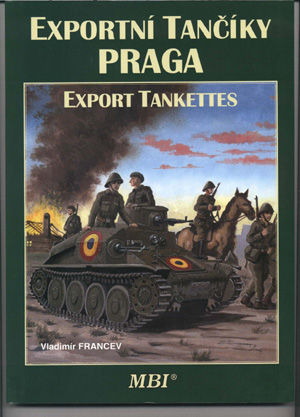Exportni Tankciky Praga, Praga
Export Tankettes
by Vladimir Francev
published by Publications MBI, ISBN 80-86524-08-6, 80 pages.

There’s plenty here to interest armour modellers, and the text
is fully bilingual in English as well as Czech. Many will be aware that
the Praga concern exported tankettes from 1936 onwards to Iran, Rumania
and Sweden but it may be news that Ethiopia also bought them in 1950.
It may also be news that none of these were what we normally think of
as tankettes, armed only with limited traverse machine guns in the hull
front. In fact all these export models were true light tanks, with machine
guns in 360 degree-traverse turrets. They were all variations on a basic
design, and although I know of no 1/35 scale kits yet there are already
kits in 1/87 and 1/72 scales of the Rumanian version that fought on the
Russian Front. Yes, I wrote “fought”, you shouldn’t
imagine that these little tanks saw no active service just because Sweden
and Iran were neutral in World War 2.
The first design was the AH-IV for Iran, with a heavy machine gun in
its turret and a light one in the hull. The hull gun was traversable but
since the driver couldn’t actually use its sights to aim it was
normally fixed in place and aimed by simply pointing the tank at a target.
Deliveries to Iran were in August 1936 and they remained in service at
least until the mid-1950s. Next came the slightly modified AH-V-R, or
R-1, for Rumania with 35 delivered in 1938. Licenced production in Rumania
was planned but only one prototype actually emerged because the Rumanian
builder went bankrupt. It was nationalised in 1941 but did not proceed
with these light tanks.
Sweden was a major customer, ordering 46 improved AH-IV-Sv in 1937 and
two more later. These were built in Sweden under licence, with many parts
supplied by Praga from the then Czechoslovakia and others, such as the
armour and engines, sourced locally. These tanks were armed with two Browning
machine guns in the turret but omitted the hull gun. Finally there was
the Ethiopian order, with 20 AH-IV-Hb’s delivered in 1950.
Each version is very fully covered here, with a chapter on its design
history and contract negotiations followed by one on its production and
another on service use. The Rumanian tanks’ combat history is fascinating!
In addition there are chapters on the camouflage and markings applied
and a full technical chapter as well.
I hardly need say that there are a host of large, clear photographs
of interiors and exteriors, plus many of the tanks on test and in service.
Add to these 1/35 scale five-view plans of each type, plus isometric drawings
pointing out their differences, and internal layout drawings with keys
to the equipment. Then add good colour plates showing camouflage and markings
for no fewer than nine examples, and a colour photograph section with
closeups of the interior and exterior of one of the eight preserved Swedish
tanks – and for good measure a 1/20 scale set of plans showing the
different turrets and roadwheels used as well as hull details. This is
one of the best single-tank references I have ever seen!
Very highly recommended. My thanks to Czech-Six Publications for the
review copy. The book can be bought from them at £11.70 plus £0.60
p&p in the UK, and they ship outside the UK as well – their
website is at www.czechsixpublications.com
with contact details to enquire for postage outside the UK, and they take
Paypal.
John Prigent
|